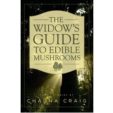There is much to praise about The Widow’s Guide to Edible Mushrooms, Chauna Craig’s début short story collection. But I was especially taken by the stories’ layered explorations of fraught relationships—and of relationships in transition, owing to divorce, death, or other circumstances.
In “This Is History,” the narrator reflects, retrospectively, on a time of transition in both her family and community. The story takes place at the site of a defunct Montana copper mine, where the narrator (then 12 years old), her parents, and brother have gathered with other locals to witness the destruction of the mine’s smokestack. For the narrator’s mother, whose father worked at the mine, the destruction is cause for sadness, even though the copper industry “left the land raped and polluted,” in the narrator’s eyes. As she observes, “My mother was susceptible to fantasies of golden pasts and golden futures that would erase the daily shin-banging and toe-stubbing of the present.”
While the destruction of the mine is one transition, the dissolution of the parents’ marriage is another. The narrator notes: “[K]nowing my mother as I do now, I can see all the ways in which that defunct smoke belcher came to represent her roots, roots that were threatened by my father’s privileged East Coast background.” It is fundamental differences like these that lead to the end of the parents’ marriage, and of the family as the narrator had known it up until then.
Yet the story captures the family just before this change, making the time at the mine—ostensibly, and sometimes in fact, a fun and engaging experience—all the more memorable and poignant. Craig writes,
In “All the Birds Vanish,” the central character, Helen, is in another type of transitional phase: figuring out who she is and what she wants post-divorce. Self-help books, friends, and family assure her that she’ll emerge from this phase a “stronger woman,” but Helen doesn’t seem so sure: “She doesn’t remember the woman she was before the divorce, not really, and she still doesn’t recognize the one she is now.”
Complicating matters are changes Helen notices in her 12-year-old son, Sam, who has been “acting up, sulking in ways that her good-natured son doesn’t.” Eventually, when he’s discovered to have been keeping a gun in his locker (for a friend, it turns out), he’s suspended from school and left to spend two uninterrupted weeks with his mother.
Craig writes with insight and feeling about this unexpected period of togetherness for mother and son. She draws us into Helen’s struggle to act as both disciplinarian and loving listener to Sam, during a precarious phase of their relationship; even before his suspension, Sam was “slipping away” from her.
One type of relationship that can be especially fraught is that between stepparents and stepchildren (or would-be stepchildren), and Craig explores the complications of such relationships in a number of stories. To me, the most heartbreaking of these is “The Stroke of Midnight,” which begins with this ominous observation by the central character, Jamie: “She [Jamie’s stepdaughter] didn’t start hating me until she was ten.”
We then get the back story of the relationship between Jamie and the stepdaughter, Bettina (a.k.a. Tina), which begins as a mutually loving connection and stays that way until Bettina’s biological mother, who had long been absent from her daughter’s life, resurfaces and wants to reestablish contact with Bettina.
When a tragedy befalls both Jamie and Bettina (I don’t want to give away the nature of it), they are pushed even further apart. In one moving scene, Jamie visits Bettina’s old bedroom, whose ceiling had been decorated, years before, with glow-in-the-dark stars:
With passages like this one, Craig vividly portrays a reality that is all too common for both step and biological parents: sometimes, all the love and care in the world are not enough to sustain a strong relationship with a child. Sometimes, too many factors are just beyond our control.
Another step-relationship is the focus of the collection’s title story, “The Widow’s Guide to Edible Mushrooms.” In this story, the widow is Margret, who has set off with her stepson, Tim, and Tim’s girlfriend, Rory, to hunt for morels in local woods. But it isn’t any ordinary mushroom hunt: Margret has brought along the ashes of her late husband (and Tim’s father), Lewis, and she has a plan for them. As she explains to Rory, the family went mushroom hunting together every spring, and she hopes to honor Lewis by “burying his ashes where we got the first good morel in his favorite hunting ground.”
As the story unfolds, we learn that Margret, like her late husband, has been concerned about Tim’s “nonchalance about his future,” and she doesn’t immediately take to Rory, whom she first sees as “mean-eyed.” Yet over the course of the journey through the woods, and during conversations afterward, Margret’s views of the couple evolve. And some news she receives from them toward the end of the story seems to point toward a hopeful future for their relationship.
As this story suggests, distances in relationships can be bridged, not necessarily perfectly or for all time. But that possibility exists, and Craig’s writing about it is nuanced and affecting.
Would My Pick be Your Pick?
If you're interested in ________, the answer may be "Yes":▪ Stories about challenging or complicated family relationships
▪ Stories with a strong sense of place






